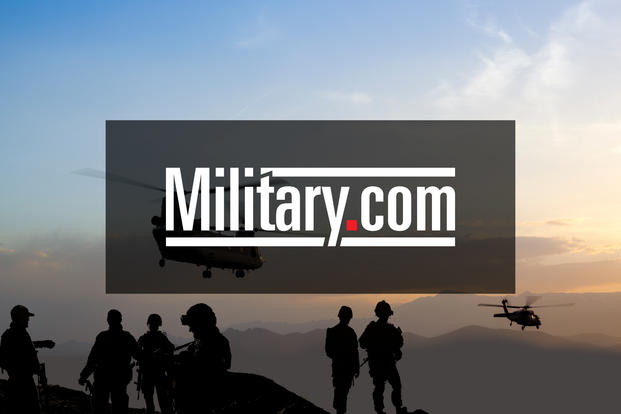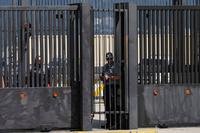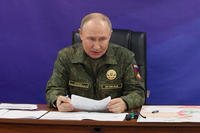On this 75th anniversary of the first nuclear weapons test, the House Armed Services Committee is working to recognize veterans who witnessed the Trinity detonation and more than 225,000 who participated in later nuclear development and testing.
Committee members approved an amendment earlier this month to the fiscal 2021 National Defense Authorization bill that would award retired service members and veterans exposed to radiation during military service -- largely those engaged in nuclear weapons development -- a service medal.
Read next: All Fires on the Bonhomme Richard Are Now Out, Navy Says
Rep. Lori Trahan, D-Massachusetts, proposed the measure on behalf of colleagues, calling for former service members to receive the proposed "Atomic Veterans Service Medal."
Veterans who served between 1945 and 1992 and were exposed to radiation became eligible to receive a service certificate under the fiscal 2019 John S. McCain National Defense Authorization Act.
But Rep. Jim McGovern, D-Massachusetts, and Rep. Tom Emmer, R-Minnesota, who have worked for five years to include the measure in the defense bill, say a piece of paper is not enough.
"It is vital to note the unique nature of this group of Atomic Veterans and the urgent need to recognize their service," McGovern and Emmer wrote in a letter to other members of Congress, urging them to support the measure earlier this year. "Tragically, upwards of 80% of American atomic veterans have already passed away, never having received this recognition. Time is running out."
Keith Kiefer is president of the National Association of Atomic Veterans. While he would not be eligible for the service medal since the Departments of Defense and Veterans Affairs do not recognize his exposure -- which occurred in 1978, cleaning up the contaminated Enewetak Atoll in the Marshall Islands -- he said it's important to the 5,000 members of his group and the families of thousands who have died from exposure-related cancers and other diseases.
"It's become a very personal thing for the family members, a recognition that their loved ones' premature deaths were not in vain and have been recognized," Kiefer said.
The estimated number of U.S. troops subjected to atomic tests is at least 225,000, according to Emmer and McGovern. They often were placed close to detonation sites in New Mexico, Nevada and the Atlantic and Pacific Oceans with no protective clothing or gear, exposed to ionizing radiation in the wake of a blast.
Former service members also were tasked with cleaning up contaminated sites, often without proper protection such as masks, hazmat suits and respirators.
"My first job was to drain a crater" left by an atomic blast in Enewetak Atoll," retired Army Sgt. Bob Celestial told Military.com. "I was waist deep in the muck. Afterward, they told me, 'Just jump in the lagoon -- that's your decontamination.' We were young soldiers. We didn't know what we were doing."
Until 1996, when the Repeal of Nuclear Radiation and Secrecy Agreements Law was passed, atomic veterans were not allowed to disclose their participation in the U.S. secret nuclear testing and development programs -- not even to doctors who have treated their cancer, autoimmune disorders and organ failure.
They also continue to fight for recognition with the VA. Although the department lists 21 types of cancer as presumed to be related to exposure to ionizing radiation, some veterans don't qualify because, like Kiefer and Celestial, the Defense Department has said the levels of exposure were minimal, or their service records don't show they were present during a blast.
"I was exposed to a 74-kiloton hydrogen bomb in 1957. I was 1.5 miles away with no protective gear. I now have cancer, and the VA has turned me down twice," said Jim Despard, who was released from the hospital Wednesday following treatment for his cancer.
"They continue to deny that we were exposed to high levels of radiation, but if the dome is still contaminated, we were the ones that built that dome," Celestial said.
He was referring to what is called the Runit Dome on the small island of Runit in the Marshall Islands. It contains 111,000 cubic yards of radioactive debris and was built and filled with dirt and debris from other locations in the atoll by more than 4,000 veterans.
Only 300 are left.
"We deserve more than a medal," Celestial said.
Veterans with one of the named conditions presumed to be related to exposure to ionizing radiation are eligible for disability compensation and VA health care. All others can apply on a case-by-case basis, which are decided based on a VA estimate of dosage, an assessment of the likelihood of exposure and medical evidence.
They also may be eligible for compensation through the Justice Department's Radiation Exposure Compensation Program.
But fewer than 2,000 veterans receive disability compensation for radiation exposure from the VA.
The nuclear age began at 5:29 a.m. on July 16, 1945, when scientists with the Manhattan Project and the U.S. Army detonated an atomic weapon containing 13 pounds of plutonium at the Trinity test site on the Alamogordo Bombing and Gunnery Range, now part of White Sands Missile Range, near Socorro, New Mexico.
Three weeks later, the U.S. dropped a uranium-fueled device on the Japanese city of Hiroshima, and three days after that, a weapon similar to the Trinity bomb on Nagasaki.
The U.S. conducted more than 1,000 nuclear tests afterward, until Sept. 23, 1992, when the last detonation took place at an underground test at the Nevada National Security Site, roughly 65 miles northwest of Las Vegas.
To mark the occasion of the Trinity blast, President Donald Trump issued a message Thursday calling the event a "remarkable feat of engineering and scientific ingenuity" that launched an "unprecedented era of global stability, scientific innovation and economic prosperity."
He said he plans to revitalize and update the country's nuclear capabilities to preserve them and is investing in producing plutonium pits to support the stockpile.
"Our nuclear weapons continue to underwrite American national security and are the backstop of our national defense," Trump said. "Having robust and diverse capabilities constrains global nuclear proliferation, deters adversaries, and assures allies and partners that rely upon American nuclear deterrence as a key component of their security."
Kiefer said his organization has been working since 1992 to get the Trinity test anniversary date officially designated as National Atomic Veterans Day.
President Ronald Reagan in 1983 issued a proclamation honoring atomic veterans on that day, but the designation was not written in perpetuity.
"We'll continue to push for recognition on this day, for designation of highways and memorials honoring our members and for compensation," Kiefer said.
Bills currently in Congress that pertain to atomic veterans also include a bill sponsored by Sen. Tina Smith, D-Minnesota, that would designate the Enewetak Atoll cleanup crews officially as "atomic veterans," eligible for VA health care and disability compensation.
The creation and distribution of the Atomic Veterans Service Medal has been estimated to cost $4 million.
-- Patricia Kime can be reached at Patricia.Kime@Monster.com. Follower on Twitter @patriciakime.
Related: 75 Years Ago Today, the Trinity A-Bomb Test Ushered in the Era of Nuclear Warfare













